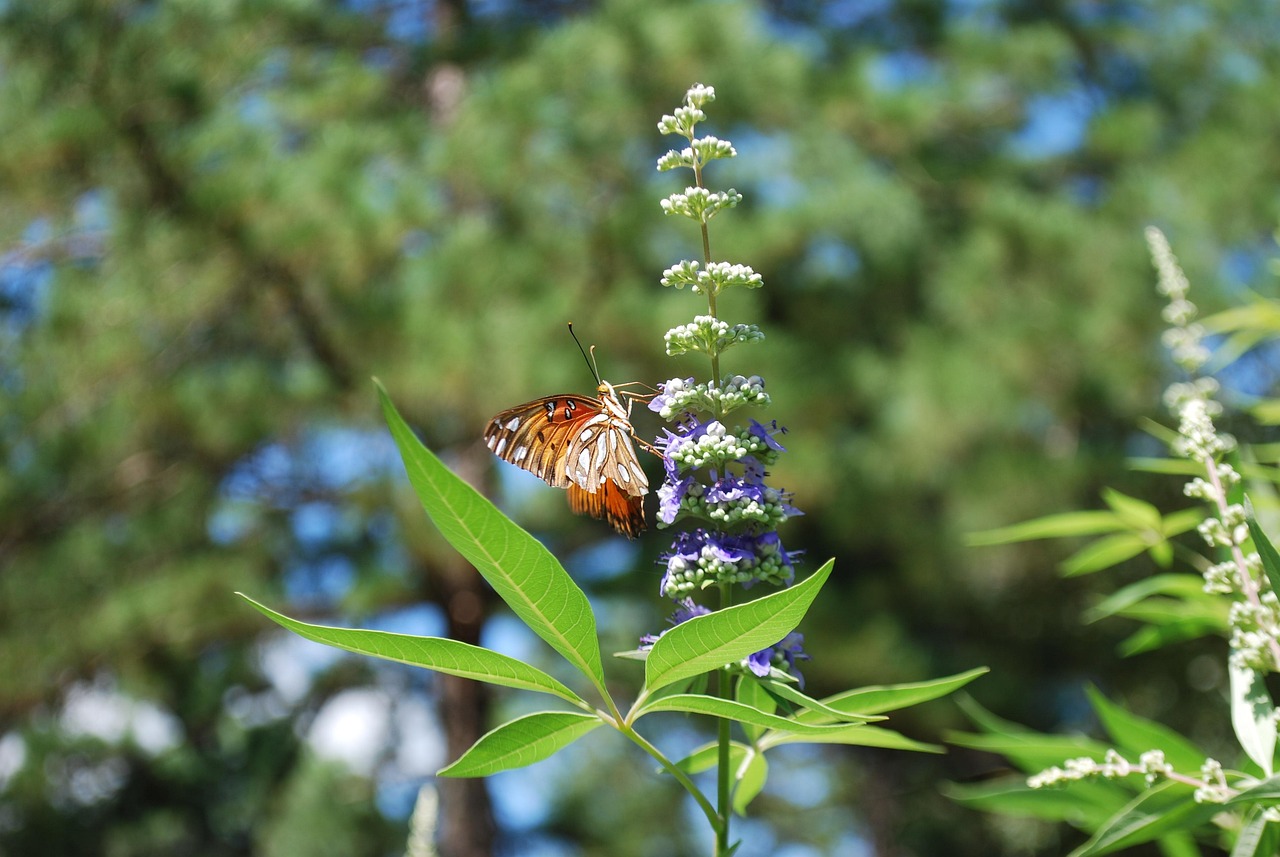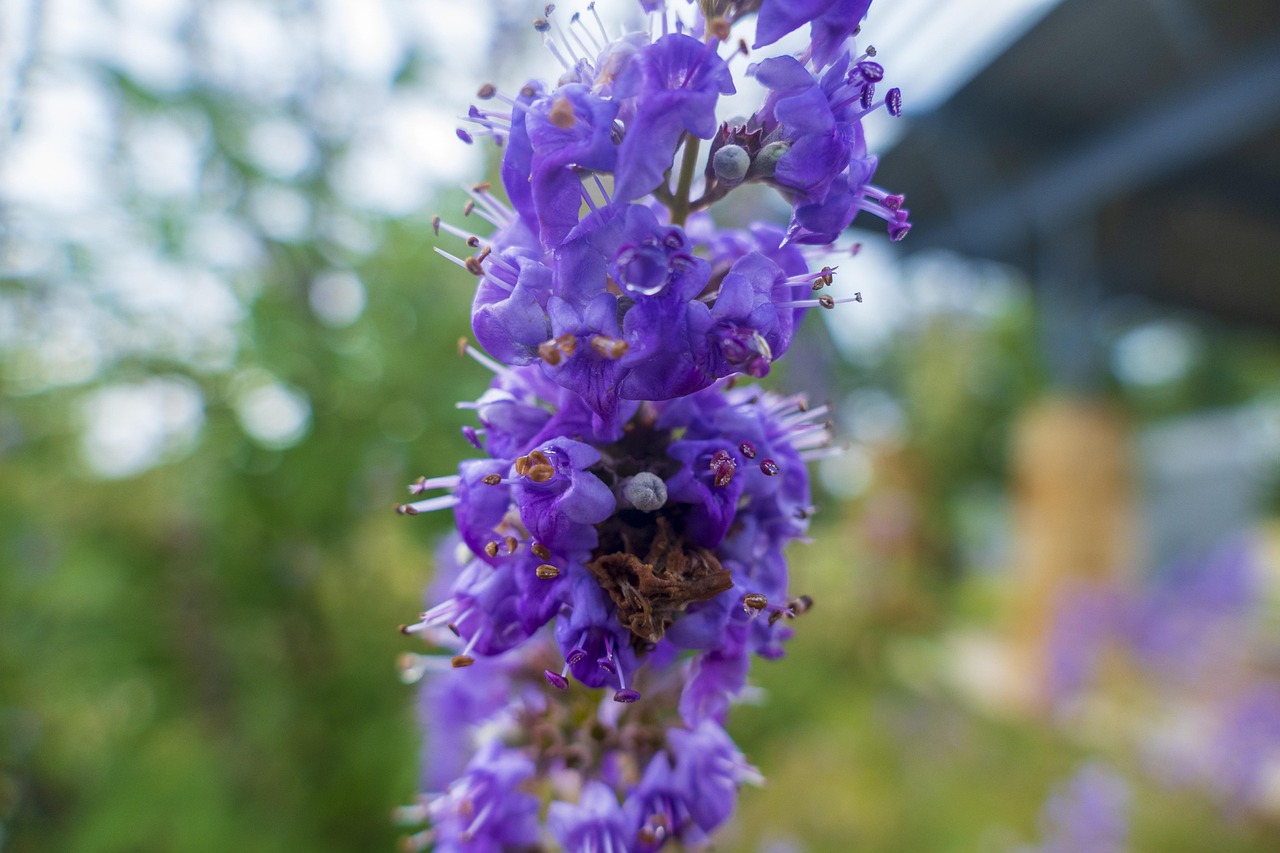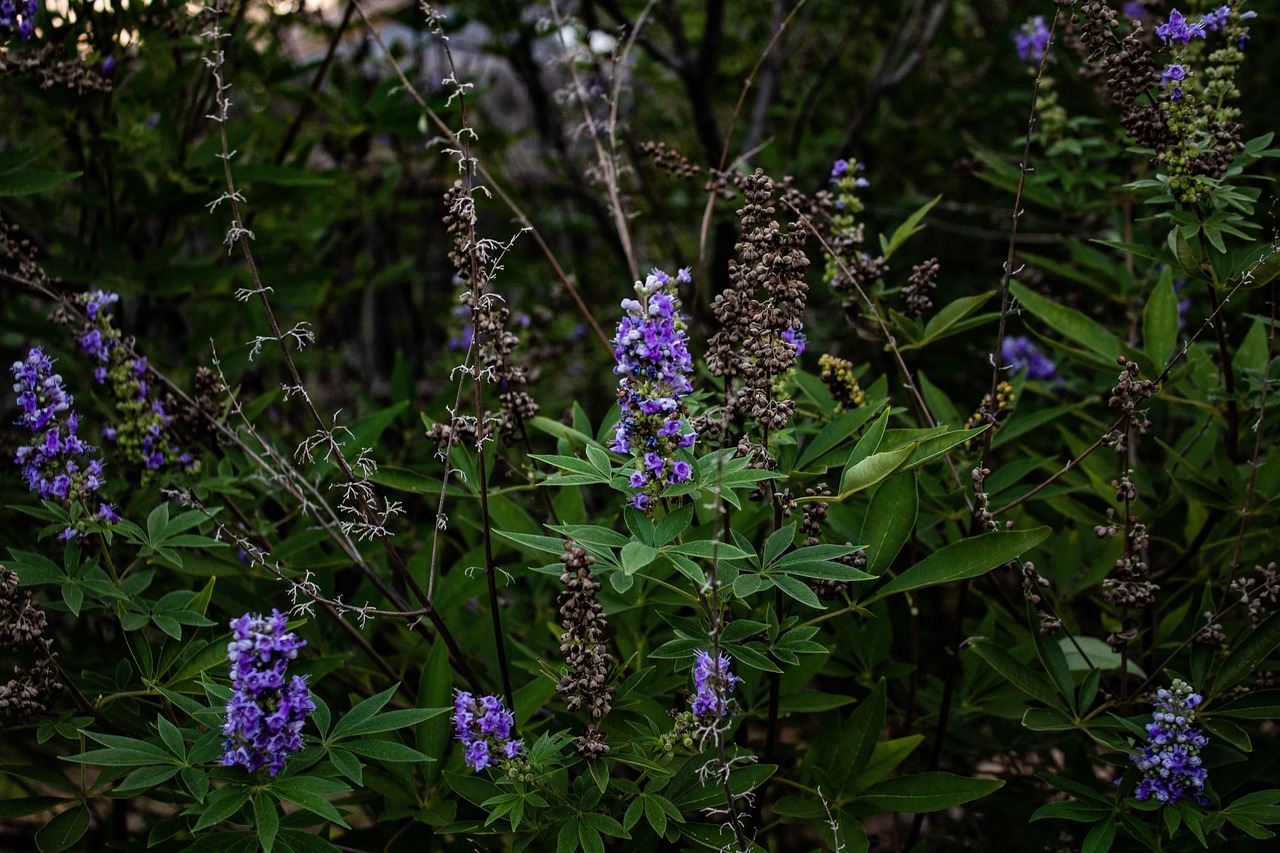Vitex, or chaste tree, typically exhibits a moderate growth rate, often reaching 3 to 5 feet per year in optimal sunny conditions. When planted in full sun, these deciduous shrubs thrive, developing lush foliage and vibrant flowers. Regular watering and well-draining soil further enhance their growth, making them an excellent choice for sunny landscapes.
The Vitex Chaste Tree typically exhibits a moderate growth rate, especially when planted in sunny locations. Under optimal conditions, it can grow 1 to 2 feet per year, reaching heights of 10 to 15 feet within a few years.
The Vitex Chaste Tree, scientifically known as Vitex agnus-castus, is a deciduous shrub or small tree that thrives in warm climates. This plant is well-known for its aromatic leaves and beautiful purple flowers. It is often used in landscaping for its ornamental value and ability to attract pollinators like bees and butterflies.

One of the essential factors influencing the growth rate of the Vitex Chaste Tree is sunlight. In sunny plantings, this tree tends to flourish and achieve its maximum growth potential. Full sun exposure allows the plant to photosynthesize effectively, leading to healthier foliage and more vibrant blooms.
Factors Influencing Growth Rate
The growth rate of the Vitex Chaste Tree can be affected by several factors, including soil quality, watering practices, and climate conditions. Understanding these elements can help gardeners optimize their planting strategies for better growth outcomes.
- Soil Quality: Well-draining soil rich in organic matter encourages robust growth.
- Watering: Regular watering during dry spells is crucial, but overwatering should be avoided as it can lead to root rot.
- Climate: Vitex thrives in USDA zones 6 to 9, where temperatures are mild to warm.
In addition to these factors, proper pruning can also influence the growth rate. Pruning helps maintain the shape of the tree and encourages new growth. It is best done in late winter or early spring before new growth begins.

Characteristics of Vitex Chaste Tree
The Vitex Chaste Tree has several notable characteristics that make it a popular choice among gardeners. It is not only admired for its appearance but also for its resilience and low maintenance requirements.
| Characteristic | Description |
|---|---|
| Height | Typically grows between 10 to 15 feet. |
| Width | The spread can range from 5 to 10 feet. |
| Flower Color | Purple, blue, or white flowers that bloom in summer. |
| Leaf Type | Palmatifid, with 5-7 leaflets. |
| USDA Zones | 6 to 9, thriving in warm climates. |
The flowers of the Vitex Chaste Tree are not just aesthetically pleasing; they also have a pleasant fragrance. This makes them an attractive option for gardens and landscapes aimed at attracting wildlife. Moreover, the tree’s dense foliage provides shade and can serve as a windbreak, enhancing its appeal for gardeners seeking multifunctional plants.
Optimal Conditions for Growth
For optimal growth, it is essential to plant the Vitex Chaste Tree in a location that receives full sunlight. A minimum of six hours of direct sunlight per day will ensure vigorous growth. Additionally, soil should be well-draining to prevent water accumulation around the roots.

Fertilization can also play a role in promoting healthy growth. A balanced fertilizer applied in early spring can provide the necessary nutrients for the tree’s development. However, it is important not to over-fertilize, as this can lead to excessive foliage growth at the expense of flowers.
Overall, understanding the growth rate and conditions favorable to the Vitex Chaste Tree is vital for successful cultivation. By providing the right environment, gardeners can enjoy this beautiful tree’s benefits for many years.
Maintenance and Care for Vitex Chaste Tree
Proper maintenance is crucial for the healthy growth of the Vitex Chaste Tree. Regular care ensures that the tree not only thrives but also remains aesthetically pleasing throughout its life. Here are some important aspects of maintaining this beautiful plant.
Watering Practices
Watering is a fundamental aspect of care for the Vitex Chaste Tree. While this tree is drought-tolerant once established, it requires consistent moisture during its initial growth phase. Here are some tips for effective watering:

- Initial Watering: Newly planted trees should be watered deeply once or twice a week during the first year. This encourages deeper root growth.
- Established Trees: After the first year, reduce watering frequency to once every two weeks, depending on rainfall.
- Soil Check: Always check the soil moisture before watering. The top inch of soil should be dry before you water again.
Pruning Techniques
Pruning is essential for shaping the tree and promoting healthy growth. It allows for better air circulation and sunlight penetration, which is crucial for flowering. Here are some guidelines for pruning the Vitex Chaste Tree:
- Timing: The best time to prune is in late winter or early spring before new growth begins.
- Tools: Use clean, sharp pruning shears to make clean cuts, which helps prevent disease.
- Method: Remove dead or damaged branches first, then shape the tree by cutting back any overly long or unruly branches to encourage bushier growth.
Pest and Disease Management
The Vitex Chaste Tree is generally resistant to pests and diseases. However, like any plant, it can be susceptible to certain issues. Awareness of potential problems can help in managing them effectively.
Common Pests
While infestations are rare, some pests may occasionally affect the Vitex Chaste Tree. Here are a few to watch for:
- Aphids: These small insects can cluster on new growth, sucking sap and causing leaves to curl. They can usually be controlled with insecticidal soap.
- Spider Mites: These pests thrive in hot, dry conditions and can cause stippling on leaves. Increasing humidity or spraying with water can help eliminate them.
- Scale Insects: They appear as small bumps on stems and leaves. Removing them by hand or treating with horticultural oil can manage infestations.
Diseases
Diseases are less common in Vitex Chaste Trees, but they can occur under specific conditions. The following are potential issues:
- Root Rot: This can happen if the tree is overwatered or planted in poorly draining soil. Ensure proper drainage to prevent this issue.
- Fungal Infections: Fungal issues may arise from high humidity or poor air circulation. Proper spacing and pruning help reduce these risks.
Fertilization Schedule
A well-planned fertilization schedule supports the overall health of the Vitex Chaste Tree. Here are some recommendations for an effective fertilization routine:
- Early Spring: Apply a balanced slow-release fertilizer to encourage healthy growth as new leaves emerge.
- Mid-Summer: A second application can be beneficial if the tree shows signs of nutrient deficiency, such as yellowing leaves.
- Avoid Late Fertilization: Do not fertilize in late summer or fall, as this may promote new growth that could be damaged by cold weather.
By adhering to these maintenance practices, gardeners can ensure that their Vitex Chaste Trees flourish in sunny plantings. The combination of proper watering, pruning, pest management, and fertilization contributes significantly to achieving optimal growth rates and overall plant health.
Propagation Methods for Vitex Chaste Tree
Propagation is an essential aspect of gardening that allows gardeners to expand their collection of plants. The Vitex Chaste Tree can be propagated through several methods, each with its advantages and challenges. Understanding these methods can help in successfully growing new trees.
Seed Propagation
Seed propagation is one of the most straightforward ways to grow new Vitex Chaste Trees. This method requires patience, as seeds may take some time to germinate. Here are key steps for seed propagation:
- Harvesting Seeds: Collect seeds from mature fruit in late summer to early fall. Ensure they are fully ripe before harvesting.
- Pre-treatment: Soak seeds in water for 24 hours to enhance germination rates.
- Sowing: Plant seeds in well-draining soil, covering them lightly with soil. Keep the soil moist but not soggy.
- Germination Time: Expect germination to occur within 2 to 4 weeks under optimal conditions.
Cutting Propagation
Taking cuttings is another effective method for propagating the Vitex Chaste Tree. This technique allows for faster growth compared to starting from seeds and produces clones of the parent plant. Here is how to propagate by cuttings:
- Timing: The best time to take cuttings is in late spring or early summer when the plant is actively growing.
- Selecting Cuttings: Choose healthy, semi-hardwood stems about 4 to 6 inches long. Remove any leaves from the lower half of the cutting.
- Dip in Hormone: Optionally, dip the cut end in rooting hormone to promote root development.
- Planting Cuttings: Place cuttings in a pot filled with a well-draining potting mix. Water thoroughly and cover with a plastic bag or dome to maintain humidity.
- Rooting Time: Roots should develop within 4 to 8 weeks. Once rooted, gradually acclimate the new plants to outdoor conditions.
Environmental Adaptability
The Vitex Chaste Tree is known for its ability to adapt to various environmental conditions. Understanding its adaptability can help gardeners select the best planting locations and care practices.
Soil Preferences
This tree is not particularly fussy about soil types, but it thrives in certain conditions:
- Well-Draining Soil: The most critical requirement is well-draining soil to prevent root rot.
- pH Level: Vitex prefers slightly acidic to neutral soil, ideally with a pH between 6.0 and 7.5.
- Soil Amendments: Incorporating organic matter such as compost can enhance soil fertility and structure.
Climate Tolerance
The Vitex Chaste Tree flourishes in warm climates but has some tolerance to varying weather patterns:
- Heat Tolerance: This tree thrives in full sun and can withstand high temperatures.
- Cold Tolerance: It can tolerate brief periods of cold but should be protected from freezing temperatures, especially when young.
- Drought Resistance: Once established, the Vitex is drought-tolerant but performs best with regular watering during dry spells.
Cultural Significance and Uses
The Vitex Chaste Tree has been valued for centuries not only for its beauty but also for its cultural and medicinal significance. Understanding its uses can enhance appreciation for this versatile plant.
Cultural Uses
The plant has a rich history in various cultures around the world:
- Traditional Medicine: Historically, Vitex has been used in herbal medicine for various ailments, including hormonal balance.
- Aesthetic Landscaping: Its attractive flowers and foliage make it a popular choice in gardens and public parks.
- Pollinator-Friendly: The flowers attract bees and butterflies, contributing to biodiversity in garden ecosystems.
Modern Applications
Today, the Vitex Chaste Tree continues to hold value in various applications:
- Landscape Design: It is often used as a specimen tree or for creating hedges due to its size and shape.
- Erosion Control: The tree’s root system helps stabilize soil, making it useful for controlling erosion on slopes.
- Culinary Uses: The fruits of the Vitex plant are sometimes used as culinary herbs or flavorings in certain cuisines.
The combination of adaptability, beauty, and historical significance makes the Vitex Chaste Tree a valuable addition to any garden, especially in sunny environments where it can thrive best. Understanding its propagation methods, environmental adaptability, and uses allows gardeners to appreciate this unique plant fully.
Benefits of the Vitex Chaste Tree in Landscaping
The Vitex Chaste Tree offers numerous benefits for landscaping beyond its aesthetic appeal. Its growth rate, particularly in sunny plantings, makes it a practical choice for various garden settings. Here are several advantages of incorporating this tree into your landscape:
- Low Maintenance: Once established, the Vitex Chaste Tree requires minimal care, making it ideal for busy homeowners or those seeking low-maintenance options.
- Attractive Foliage: The lush green leaves provide a beautiful backdrop for the stunning blooms that appear in summer, enhancing the visual interest of any garden.
- Wildlife Habitat: By attracting pollinators such as bees and butterflies, this tree contributes to a healthy ecosystem and supports local wildlife.
- Versatility: The Vitex can be used in various garden styles, from formal landscapes to cottage gardens, due to its adaptable nature.
Considerations for Planting Vitex Chaste Trees
While the Vitex Chaste Tree is an excellent addition to many landscapes, there are several considerations to keep in mind when planting:
- Space Requirements: Ensure adequate space for growth, as the tree can reach heights of 10 to 15 feet and a spread of 5 to 10 feet. Planting too close to structures or other plants can lead to overcrowding.
- Sunlight Exposure: Choose a planting location that receives full sun to support optimal growth rates and flowering. A minimum of six hours of direct sunlight daily is ideal.
- Soil Drainage: As previously mentioned, well-draining soil is crucial. Conduct a soil test if unsure about drainage capabilities or soil quality.
Potential Challenges and Solutions
Like any plant, the Vitex Chaste Tree may face challenges during its growth. Being aware of potential issues can help gardeners take proactive measures:
- Pest Management: Regular monitoring can help identify pests early. Use organic methods like insecticidal soap for control, and encourage natural predators such as ladybugs.
- Disease Prevention: Avoid overhead watering to reduce fungal diseases. Ensure proper air circulation by spacing plants adequately.
- Winter Protection: In colder climates, consider mulching around the base of young trees to protect roots from freeze damage during winter months.
Final Thoughts
The Vitex Chaste Tree is an exceptional species that offers beauty, resilience, and ecological benefits when planted in sunny environments. Its moderate growth rate combined with its low maintenance requirements makes it an ideal choice for both novice and experienced gardeners. By understanding its optimal growing conditions, propagation methods, and care practices, gardeners can successfully incorporate this versatile tree into their landscapes.
In summary, the Vitex Chaste Tree not only enhances the visual appeal of gardens but also plays a vital role in supporting local wildlife and promoting biodiversity. Its adaptability to various soil types and climates makes it a valuable addition to diverse garden settings. By choosing the right planting location and providing proper care, gardeners can enjoy the many benefits this remarkable tree provides for years to come.
As you consider your gardening projects, think about including the Vitex Chaste Tree in your plans. Its combination of ornamental beauty and practical advantages makes it a standout choice for anyone looking to create a vibrant and thriving landscape.
